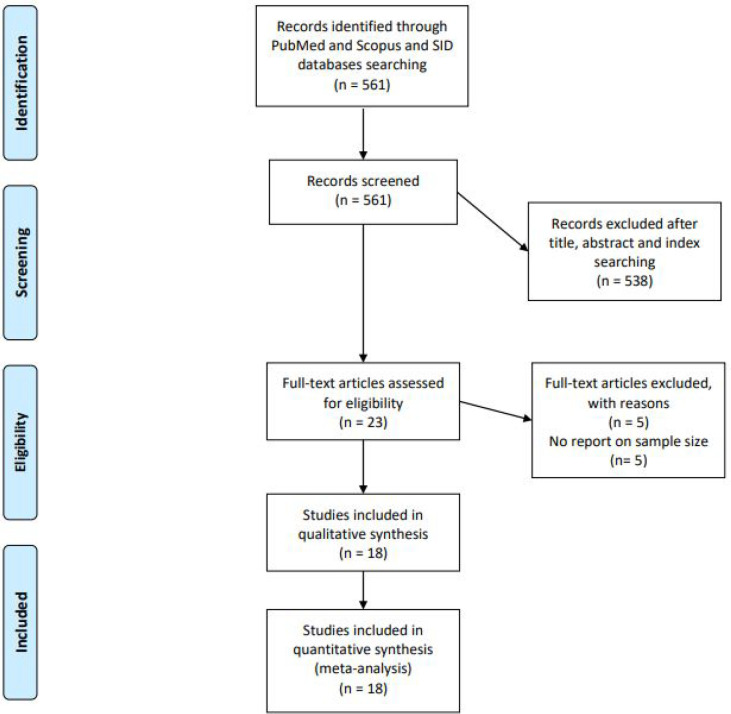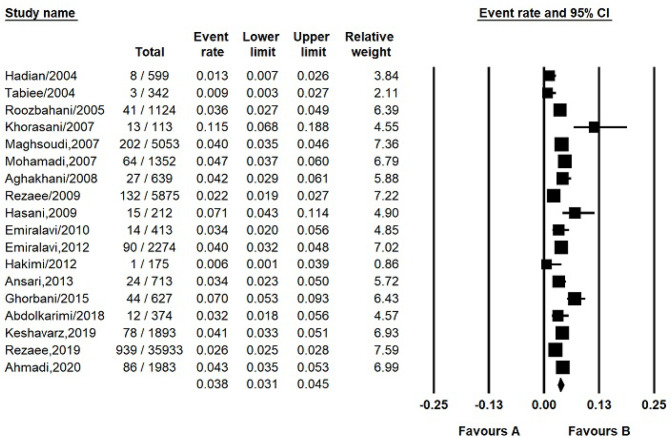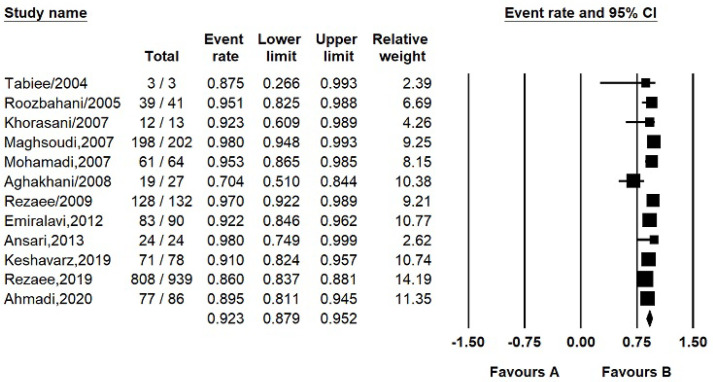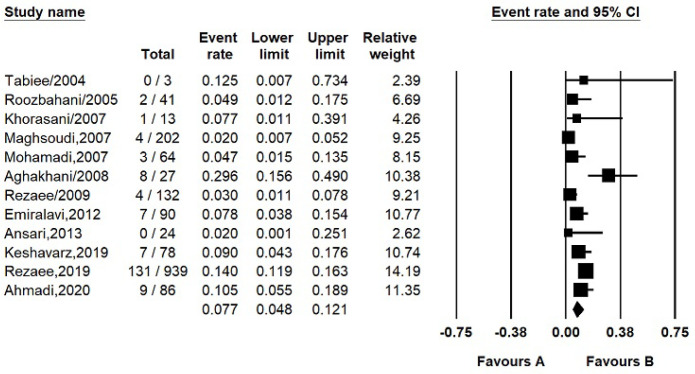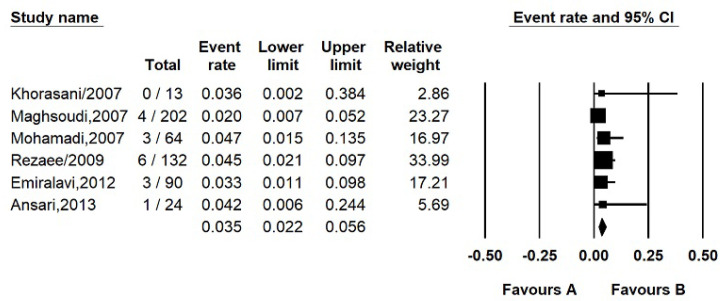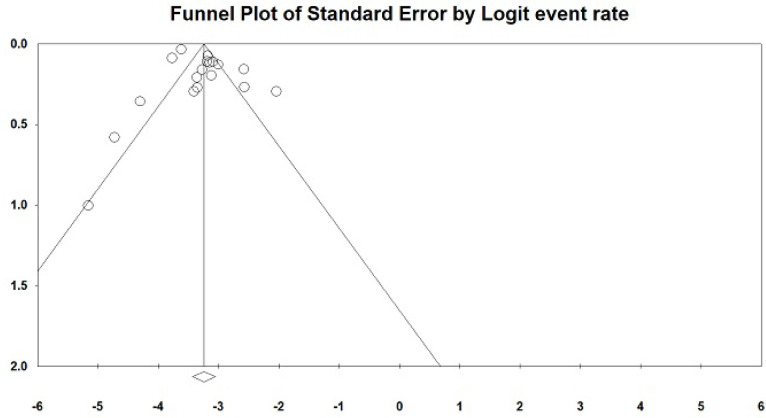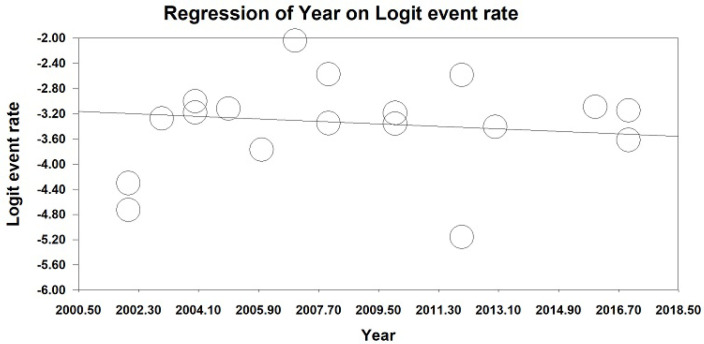Abstract
BACKGROUND
Electrical burn, one of the serious public health challenges, is considered one of the most devastating due to higher mortalities. Burn injuries impose a high economic burden on patients, the health system, and society. We aimed to determine the prevalence of electrical burn injury among burn patients hospitalized in Iran.
METHODS
A systematic literature search was conducted to identify articles published from Iran in the electronic databases of Scopus, PubMed, Embase, Google Scholar, Web of Science, and SID from Jan 2000 to Dec 2020. Next, eight publications from international databases and ten articles from the Persian SID database that met our inclusion criteria were selected for data extraction and meta-analysis. The inclusion criteria were articles done among the Iranian population with burn patients.
RESULTS
In all studies, the pooled prevalence of electrical burn was estimated at 3.8% (95% CI: 3.1% – 4.5%) in burn patients. Occurrence of electrical burn-in males and females was 92.3% (95% CI: 87.9% – 95.2%) and 7.7% (95% CI: 4.8% – 12.1%) respectively. Also, the mortality rate was 3.5% (95% CI: 2.2% – 5.6%).
CONCLUSION
The epidemiological study of electrical burns helps determine the effective factors in the occurrence of this type of damage.
Key Words: Electrical injury, Burn, High voltage, Low voltage
INTRODUCTION
Burn injuries are under-appreciated trauma that is related to considerable morbidity and mortality. It not only affects physical and mental health but threat patients’ quality of life. It occurs in all ages, with the majority among children and old age1. Burns is one of the most common traumatic injuries worldwide, especially in developing countries such as Iran. Burn injuries are prevalent in low- and middle-income countries, but their prevalence decreases in high-income countries2,3.
Regarding reports by WHO, the annual worldwide incidence of burn injuries in all types was estimated at 11 million burns, of which 180,000 were fatal4. Although the majority of burn injuries are caused by hot liquids or fire, they can be raised by cold, friction, radiation, and electric or chemical sources1. The immediate care for burn injury is related to the injury site, the source of burn (thermal, electric, or chemical), and the availability of care resources.
As one of the most critical concerns of the public health care system in industrialized countries, an electric burn injury can lead to severe complications and socioeconomic problems. It may result in severe and extensive burns and is accountable for high mortality and morbidity worldwide5,6. The mortality rate varies depending on the socioeconomic level, including 3%-15% in developed countries versus 21%-27% in developing countries7. According to recent reports, its’ mortality rate was 20%8. Previous studies have shown variation in the prevalence and epidemiology of electrical burns. Annually, electric burn injuries are estimated to be more than 3,000 admissions to burn centers in the USA, accounting for 3%-4% of all burn injuries9-12. Elsewhere, in a burn center in Pakistan, 85 children were admitted with electric burn injuries, 71.76% due to high voltage12. Based on reports of a registry-based study in Iran, electrical burn injuries occurred in 5.6% of burns13. Most electrical burns occurred in ages 21 to 50 yr and affected men more than women (89.4% vs 10.6%). Work-related accidents (46%) and electrical accidents indoors (19.4%) are the most common causes of electrical injuries. Electric burns are still a leading cause of amputation, leading to physical disability and mental health problems. There were significant amputations (25.8% vs 5.03%) and more complications (87.10% vs 67.9%) in cases whit high-voltage burns. The coma was the main complication with the highest incidence, followed by heart damage, liver injury, acute renal failure, lung injury, and shock14.
In a review of the literature, there was no more information on electric burn injuries in Iran. Understanding the epidemiology of burns can help develop preventative measures and treatment of electrical burns injuries, which depends on geographical and socio-economic differences. Because of the necessity of updating the previous knowledge, this study was conducted to assess the epidemiology and rate of electrical burn injuries in Iran.
METHODS
Study design and search strategies
We performed a systematic review according to the Preferred Reporting Items for Systematic Reviews and Meta-Analyses (PRISMA) guidelines. This was done by searching multiple electronic bibliographic databases, including Scopus, PubMed, Google Scholar, Embase, Web of Science, and SID, from database beginning Jan 2000 to Dec 2020 to find relevant studies. The search for keywords was done in the title or abstract or keywords fields or within the full text of the articles. For this purpose, we used a combination of predefined keywords, including “Burns, Electric,” “Electrical injury,” “electrical burn,” “Electrical burn injury,” “electrical injury complication,” “electrical injury squeal,” “high voltage,” “low voltage” and words like lightning, children, adults, morbidity, mortality, and amputation.
Selection criteria and quality assessment
Two reviewers separately screened the search results in the databases with relevant keywords to apply eligibility for inclusion. They analyzed the titles, abstracts, and full texts, and any disagreement between reviewers was resolved through discussion. There was no limitation regarding the language of publication, but the abstract had to be available in English or Persian. The study was limited to cross-sectional articles indexed in the Scopus or PubMed or Google Scholar or Embase or Web of Science or SID. Articles with the following criteria were then included in the study: 1) Studies relating to outcomes of electrical injury among burn patients. And 2) databases from Jan 2000 to Dec 2020. Review articles, case reports, and congress abstracts with no necessary information were further excluded. Moreover, studies of lightning electrical damages alone were excluded. The reference lists of related studies were also reviewed for any other related publications.
Quality assessment and data extraction
Two researchers independently assessed the quality using the nine-point critical appraisal checklist by Joanna Briggs Institute (JBI) for studies reporting the prevalence data, and discrepancies were resolved through consensus15. The studies included more than half of the quality evaluation parameters. Afterward, the two researchers extracted the following data from eligible studies: authors’ names, time of conducting the research, published time, geographical distribution, sample size, and prevalence of electrical burn. To reach a consensus, the inconsistencies between the researchers were further discussed.
Statistical analysis
Data analysis was performed using the random-effects model to estimate the pooled prevalence and corresponding 95% confidence interval (CI). Between-study Statistical heterogeneity was assessed using the Cochran’s Q statistic and I-square (I2) test. Publication bias was graphically evaluated by a funnel plot and mathematically evaluated using Begg’s rank correlation and Egger’s weighted regression test (P<0.05 was considered indicative of statistically significant publication bias). A meta-regression using the random-effect model (method of moments) was done to determine whether or not the prevalence of electrical injury was modulated by time (performed years). Meta-regression coefficients (slopes of the meta-regression line) indicate the estimated log events rate per unit increase in the covariate. Analysis of data and construction of graphs were done by Comprehensive Meta-Analysis Software Version 2.2 (Biostat, USA).
RESULTS
Our systematic and comprehensive search identified eighteen studies that surveyed the prevalence of electrical burn among hospitalized patients16-33. Figure 1 presents a flowchart of the literature search and study selection. The included articles had been conducted in thirteen provinces of Iran. Table 1 shows summarize of the detailed characteristics of each article recorded in the meta-analysis. All of the included articles reported the prevalence of electrical burn among burn injury inpatients (Figure 2), of which the pooled prevalence of electrical burn was estimated at 3.8% (95% CI: 3.1%-4.5%), and there was heterogeneity among electrical burn in the included study (χ2 =170.572; P<0.001; I2=90%). According to subgroup analysis by gender, the overall occurrence of electrical burn-in males and females was 92.3% (95% CI: 87.9%-95.2%) and 7.7% (95% CI: 4.8%-12.1%), respectively, reported in twelve studies (Figures 3,4). Moreover, the reported occurrence of electrical burn mortality in four studies was 3.5% (95% CI: 2.2%-5.6%) (Figure 5). Four studies20, 21, 23, 28 reported hospitalization during electrical burn patients from 4.7 to 15.2 days. Based on three studies20, 21, 23, 67.2%, 54%, and 75.7% of electrical burns occurred due to high-voltage electricity, respectively. The extent of burn area was reported in three studies ranged from 10% to 27.5% TBSA (Total Body Surface Area). The symmetric funnel plot did not show any evidence of strong publication bias (Figure 6) and was confirmed by the results of Begg’s rank correlation and Egger’s regression. Meta-regression results revealed that the occurrence of electrical injury among burns insignificantly decreased annually, with a coefficient of -0.02 % (95% CI: -0.03%– -0.01%, P<0.001) (Figure 7).
Fig. 1.
Flow chart of the literature search strategy and study selection
Table 1.
Characteristics of studies included in the meta-analysis
| First autor/ Publication year | Performed time | Mean age | Sample size | Electrical burn | M/F |
low/high
Voltage |
Hospitalized time | Mortality | Quality check (%) | Ref. |
|---|---|---|---|---|---|---|---|---|---|---|
| Hadian/2004 | 2002 | 5.8 | 599 | 8 | - | - | - | - | 60 | |
| Tabiee/2004 | 1998-2002 | 23.1 | 342 | 3 | 3/0 | - | - | - | 70 | |
| Roozbahani/2005 | 2003 | 23.3 | 1124 | 41 | 39/2 | - | - | - | 70 | |
| Khorasani/2007 | 2006-2007 | - | 113 | 13 | 12/1 | - | - | 0 | 80 | |
| Maghsoudi,2007 | 1999-2004 | 27.5 | 5053 | 202 | 198/4 | 85/109 | 13.9 | 4 | 90 | |
| Mohamadi,2007 | 2002-2004 | 30.5 | 1352 | 64 | 61/3 | 21/43 | 11.5 | 3 | 90 | |
| Aghakhani/2008 | 2005 | 23.6 | 639 | 27 | 19/8 | - | - | - | 70 | |
| Rezaee/2009 | 2002-2006 | 26 | 5875 | 132 | 128/4 | 31/100 | 15.2 | 6 | 90 | |
| Hasani,2009 | 2007-2008 | - | 212 | 15 | - | - | - | - | 60 | |
| Emiralavi/2010 | 2008 | 3.76 | 413 | 14 | - | - | - | - | 60 | |
| Emiralavi,2012 | 2007-2010 | 31.5 | 2274 | 90 | 83/7 | - | - | 3 | 80 | |
| Hakimi/2012 | 2012 | 2.5 | 175 | 1 | - | - | - | - | 60 | |
| Ansari,2013 | 2008-2010 | - | 713 | 24 | 24/0 | - | 4.7 | 1 | 90 | |
| Ghorbani/2015 | 2010-2012 | 627 | 44 | - | - | - | - | 60 | ||
| Abdolkarimi/2018 | 2007-2013 | 71.5 | 374 | 12 | - | - | - | - | 60 | |
| Keshavarz,2019 | 2008-2017 | 6.5 | 1893 | 78 | 71/7 | - | - | - | 70 | |
| Rezaee,2019 | 2017 | 29.3 | 35933 | 939 | 808/131 | - | - | - | 70 | |
| Ahmadi,2020 | 2014-2016 | - | 1983 | 86 | 77/9 | - | - | - | 70 |
Fig. 2.
Forest plots of the overall prevalence of electrical injury among burns in Iran
Fig. 3.
Forest plots of the overall prevalence of electrical burn injury in males
Fig. 4.
Forest plots of the overall prevalence of electrical burn injury in females
Fig. 5.
Forest plots of mortality rate in electrical burns patients
Fig. 6.
Funnel plot of the prevalence of electrical injury among burns in Iran
Fig. 7.
Meta-regression of electrical burn injury rate among burn patiens
DISCUSSION
Based on WHO report, 195,000 deaths occur due to burns yearly, most (95%) of them in developing countries34. Although electrical burn is a less prevalent type of burn injury nowadays, however, that is one of the most destructive kinds of trauma owing to high morbidity and mortality with a higher occurrence in developing areas35. Various studies worldwide are different in reported frequency and epidemiology for electrical burns, but they usually contain nearly 21%–27% of all admissions to burn centers in developing countries versus 0.04% to 5% in developed ones8, 14.
In our study, the frequency of electrical burn (3.8%) was lower in comparison to some other reports from Turkey (16%), Kosovo (17%), China (18%), and a five-year survey in Iran (10.8%) but it was close to other study done in the USA (4%)35. Consistent with our study, men are more prone to electrical damages than women. For example, in the studies, 97.8%, 82%, 89%, 95%, and 92.5% of patients with electrical burn injuries were males, respectively35, 36. Regarding the prevalence of electrical injury in men and the workplace, this may be because men are often higher exposed to electrical appliances and engage in high-risk jobs35, 37. The mean age of electrical injuries patients in various studies is different. In some studies, the mean age of electrical injuries patients was reported as 30.2 or 25 years38-40. The mean age in a 5-year study in Turkey was 18.8 yr in women and 27.4 yr in men36. Moreover, most of the patients were with a mean age of 3037. Our studies reported an average age of 2.5 to 71.5 yr, depending on the study population.
Electrical burn injuries are classed as high-voltage (≥1000V) and low-voltage (<1000V). High-voltage burns due to the exert of high energy cause severe damage to the tissues 41, 42. In Pakistan and Turkey, most of the patients with electrical burn were injured by high-voltage electrical current, 71.76% and 54.5%, respectively14, 38. While most of the patients were injured by low voltage43. In our survey, three studies20, 21, 23 were reported 67.2%, 54%, and 75.7% of electric burns caused by high voltage electricity, respectively. Electrical burns are characterized by varied mortality ratios ranging from 2.35% to 26.7%14. In the present study, the mortality rate was 3.5%, which is similar to several studies. In other studies, a mortality rate of 2.8%-6% was reported44, 45. In addition, in a 20-year survey in the USA, the mortality rate in burns due to high voltage was 5.3% and by low voltage was 2.8%. Moreover, the hospital stay in the electrical burn was shorter with 18.9 d versus 26.2 d in other types of burn46. In our review, the hospitalization duration of electrical burn patients was reported from 4.7 to 15.2 days. Furthermore, in our study, the TBSA was ranged from 10% to 27.5%. In the Kurt study, the mean TBSA was 21.8% of high-voltage burns and 11.9% of low-voltage burns36. Based on a study, patients with high-voltage burns usually had more broad TBSA burns and longer hospitalization than those with low-voltage burns14. Longer hospitalization in electrical burn patients could be related to simultaneous and various limbs injuries in high-voltage electrical shock, such as falling47.
CONCLUSION
Electrical burns are a main public health problem, and their prevention should be emphasized in male and high-voltage injuries. Preventive strategies are essential to decrease the incidence of this type of burn. Protection training should be compulsive at work, such as the ability to disconnect from electrical sources immediately. Information about electrical devices, employment of expert and skilled persons, using labor standards and security systems, use of warning signs, and Public education programs in Iran can be helpful to reduce the incidence of electrical injuries. Future multicenter and long-term follow-up studies are needed to provide a comprehensive and correct knowledge of electrical burns in Iran. In the present study, we analyzed published studies that investigate the rate of electrical burn-in Iran. This study is the first Meta-analysis on electrical injury rate among burn patients during 20-year in Iran.
CONFLICT OF INTEREST
The authors declare no conflicts of interest in this work.
ACKNOWLEDGMENTS
None declared.
References
- 1.Jeschke MG, van Baar Margriet E, Choudhry MA, Chung KK, Gibran NS, Sarvesh L. Burn injury (Primer) Nat Rev Dis Primers. 2020;6:1. doi: 10.1038/s41572-020-0145-5. [DOI] [PMC free article] [PubMed] [Google Scholar]
- 2.Smolle C, Cambiaso-Daniel J, Forbes AA, et al. Recent trends in burn epidemiology worldwide: a systematic review. Burns. 2017;43(2):249–57. doi: 10.1016/j.burns.2016.08.013. [DOI] [PMC free article] [PubMed] [Google Scholar]
- 3.Greenhalgh DG. Management of burns. N Engl J Med. 2019;380(24):2349–59. doi: 10.1056/NEJMra1807442. [DOI] [PubMed] [Google Scholar]
- 4.Almarghoub MA, Alotaibi AS, Alyamani A, et al. The epidemiology of burn injuries in Saudi Arabia: a systematic review. J Burn Care Res. 2020;41(5):1122–7. doi: 10.1093/jbcr/iraa084. [DOI] [PubMed] [Google Scholar]
- 5.Handschin AE, Vetter S, Jung FJ, Guggenheim M, Künzi W, Giovanoli P. A case-matched controlled study on high-voltage electrical injuries vs thermal burns. J Burn Care Res. 2009;30(3):400–7. doi: 10.1097/BCR.0b013e3181a289a6. [DOI] [PubMed] [Google Scholar]
- 6.Hussmann J, Kucan J, Russell R, Bradley T, Zamboni WA. Electrical injuries—morbidity, outcome and treatment rationale. Burns. 1995;21(7):530–5. doi: 10.1016/0305-4179(95)00037-c. [DOI] [PubMed] [Google Scholar]
- 7.Aggarwal S, Maitz P, Kennedy P. Electrical flash burns due to switchboard explosions in New South Wales—a 9-year experience. Burns. 2011;37(6):1038–43. doi: 10.1016/j.burns.2011.01.017. [DOI] [PubMed] [Google Scholar]
- 8.Habouchi S, Bouamra A, Bezzaoucha A, Joucdar S. Estimation of survival rate in electrical injuries, experience in Algerian Burn Centers. Burns Open. 2020;4(4):141–5. [Google Scholar]
- 9.Saaiq M. Epidemiology and outcome of childhood electrical burn injuries at Pakistan Institute of Medical Sciences Islamabad, Pakistan. J Burn Care Res. 2016;37(2):e174–e80. doi: 10.1097/BCR.0000000000000202. [DOI] [PubMed] [Google Scholar]
- 10.Baxter CR, Waeckerle JF. Emergency treatment of burn injury. Ann Emerg Med. 1988;17(12):1305–15. doi: 10.1016/s0196-0644(88)80356-1. [DOI] [PubMed] [Google Scholar]
- 11.Spies C, Trohman RG. Narrative review: Electrocution and life-threatening electrical injuries. Ann Intern Med. 2006;145(7):531–7. doi: 10.7326/0003-4819-145-7-200610030-00011. [DOI] [PubMed] [Google Scholar]
- 12.Browne B, Gaasch W. Electrical injuries and lightning. Emerg Med Clin North Am. 1992;10(2):211–29. [PubMed] [Google Scholar]
- 13.Khazaei S, Shirani F, Afshari M, et al. Etiology and outcome of burns in Hamadan, Iran: A registry-based study. Arch Trauma Res. 2019;8(3):144–8. [Google Scholar]
- 14.Ding H, Huang M, Li D, Lin Y, Qian W. Epidemiology of electrical burns: a 10-year retrospective analysis of 376 cases at a burn centre in South China. J Int Med Res. 2020;48(3):0300060519891325. doi: 10.1177/0300060519891325. [DOI] [PMC free article] [PubMed] [Google Scholar]
- 15.Munn Z, Moola S, Lisy K, Riitano D, Tufanaru C. Methodological guidance for systematic reviews of observational epidemiological studies reporting prevalence and cumulative incidence data. Int J Evid Based Healthc. 2015;13(3):147–53. doi: 10.1097/XEB.0000000000000054. [DOI] [PubMed] [Google Scholar]
- 16.HADIAN JM, Sajedi F, Sanei Y. The incidence of electrical, chemical and thermal burns in children and adolescents referred to mottahari hospital in Tehran in 2002. RJMS. 2004;11(43):861–6. [Google Scholar]
- 17.Tabiee S, Nakhaee M. Epidemiology of burn patients in Emam Reza Hospital, Birjand, 1998–2002. J Shahrekord Univ Med Sci. 2004;6(1):43–51. [Google Scholar]
- 18.Rouzbahani R, Zamani A, Omranifard M, Rouzbahani A, FaragZadegan Z, Rezaei F. An epidemiological study on Burned patients admitted to Imam Mousa Kazem hospital, Isfahan, 2003-2004. J Shahrekord Univ Med Sci. 2005;7(1):79–89. [Google Scholar]
- 19.Khorasani G, Salehifar E, Eslami G. Causes of burns and their outcomes in patients hospitalized in the burn division of zare hospital 2006-2007. J Maz Univ Med Sci. 2007;17(61):122–30. [Google Scholar]
- 20.Maghsoudi H, Adyani Y, Ahmadian N. Electrical and lightning injuries. J Burn Care Res. 2007;28(2):255–61. doi: 10.1097/BCR.0B013E318031A11C. [DOI] [PubMed] [Google Scholar]
- 21.Mohammadi AA, Amini M, Mehrabani D, Kiani Z, Seddigh A. A survey on 30 months electrical burns in Shiraz University of Medical Sciences Burn Hospital. Burns. 2008;34(1):111–3. doi: 10.1016/j.burns.2006.12.007. [DOI] [PubMed] [Google Scholar]
- 22.Aghakhani N, Rahbar N, Feizi A, Karimi H, Vafa Shoar N. Epidemiology of hospitalized patients in burn ward of Imam Khomeini Hospital in Urmia (2005) J Kerman Univ Medical Sci. 2008;12(2) [Google Scholar]
- 23.Rezaei E, Motamedoshariati M, Safari H. A Study of Electrical Injuries in Emam Reza Burn Center of Mashhad. MJMS. 2009;52(2):107–12. [Google Scholar]
- 24.Hasani L, AGHA MT, Boushehri E, Sabili A. Analysis of hospitalized burned patients in Bandar Abbass, Iran. J Res Health Sci. 2009;9(1):50–3. [PubMed] [Google Scholar]
- 25.Emir Alavi S, Tolouei M, Shodjaei H, Kouchakinejad L. Epidemiology of childhood burns in children referred to Velayat Burn University Hospital of Rasht during 2008-9. KAUMS Journal (FEYZ) 2011;14(5):512–9. [Google Scholar]
- 26.Alavi CE, Salehi SH, Tolouei M, Paydary K, Samidoust P, Mobayen M. Epidemiology of burn injuries at a newly established burn care center in rasht. Trauma Mon. 2012;17(3):341. doi: 10.5812/traumamon.6991. [DOI] [PMC free article] [PubMed] [Google Scholar]
- 27.Hakimi H, Shafipoor SZ, Kazem Nezhad Leili E. Characteristics of burn children in Guilan Province. J Holist Nurs Midwifery. 2012;22(1):9–15. [Google Scholar]
- 28.Ansari-Moghaddam A, Baghbanian A, Dogoonchi M, Chooban B, Mostaghim-Roudi M, Torkfar G. Epidemiology of burn injuries in south-eastern Iran: a retrospective study. J Pak Med Assoc. 2013;63(12):1476–81. [PubMed] [Google Scholar]
- 29.Ghorbani F, Shiri M, Mortaqhy-Ghasemi M, Ansari P, Mohammadi F. Epidemiologic study of burn patients hospitalized in Mousavi Hospital, Zanjan 2010-2012. Prev Care Nurs Midwifery J. 2016;5(2):65–74. [Google Scholar]
- 30.Abdolkarimi L, Taftachi F, Hayati F, Mehrpisheh S, Moghadam N. Epidemiologic study of burns in elderly people over 60 years old. Tehran Univ Med J. 2018;76(4):271–6. [Google Scholar]
- 31.Keshavarz M, Javanmardi F, Mohammdi AA. A decade epidemiological study of pediatric burns in south west of Iran. World J Plast Surg. 2020;9(1):67. doi: 10.29252/wjps.9.1.67. [DOI] [PMC free article] [PubMed] [Google Scholar]
- 32.Rezaee R, Alimohamadzadeh K, Hossini S-M. Epiemiologic features and hospitalization cost of burn injuries in Iran based on national burn registry; a cross-sectional study. Arch Acad Emerg. 2019;7:1. [PMC free article] [PubMed] [Google Scholar]
- 33.Ahmadi A, Bagheri Ruchi A, Soltani N, Amirzadeh Iranagh J, Motalebi SA. Epidemiological Study of 1938 Burn Patients from 2014-2016 in Qazvin, Iran. Trauma Mon. 2020;25(2):83–8. [Google Scholar]
- 34.Karami Matin B, Rezaei S, Moghri J. Epidemiology and Hospitalization Cost of Patients Died Due To Burn Injuries: a Survey of Provincial Data. Int J Hosp Res. 2014;3(2):83–8. [Google Scholar]
- 35.Ghavami Y, Mobayen MR, Vaghardoost R. Electrical burn injury: A five-year survey of 682 patients. Trauma Mon. 2014;19(4):29–33. doi: 10.5812/traumamon.18748. [DOI] [PMC free article] [PubMed] [Google Scholar]
- 36.Kurt A, Yıldırım K, Yağmur Ç, et al. Electrical burns: Highlights from a 5-year retrospective analysis. Ulus Travma Acil Cerrahi Derg. 2016;22(3):278–82. doi: 10.5505/tjtes.2015.55491. [DOI] [PubMed] [Google Scholar]
- 37.Aghakhani K, Heidari M, Okazi A, Yousefinejad V, Abdolkarimi L. Electrical burn patients according to electrical voltage in Shahid Motahari Burn Center. Int J Med Toxicol Leg Med. 2015;5(1 (Winter)):17–21. [Google Scholar]
- 38.Karadaş S, Gönüllü H, Oncü MR, Işık D, Canbaz Y. The effects on complications and myopathy of different voltages in electrical injuries. Ulus Travma Acil Cerrahi Derg. 2011;17(4):349–53. doi: 10.5505/tjtes.2011.15483. [DOI] [PubMed] [Google Scholar]
- 39.Kopp J, Loos B, Spilker G, Horch RE. Correlation between serum creatinine kinase levels and extent of muscle damage in electrical burns. Burns. 2004;30(7):680–3. doi: 10.1016/j.burns.2004.05.008. [DOI] [PubMed] [Google Scholar]
- 40.Blackwell N, Hayllar J. A three year prospective audit of 212 presentations to the emergency department after electrical injury with a management protocol. Postgrad Med J. 2002;78(919):283–5. doi: 10.1136/pmj.78.919.283. [DOI] [PMC free article] [PubMed] [Google Scholar]
- 41.Ten Duis H. Acute electrical burns. Semin Neurol. 1995:381–6. doi: 10.1055/s-2008-1041048. [DOI] [PubMed] [Google Scholar]
- 42.Cooper MA. Emergent care of lightning and electrical injuries. Semin Neurol. 1995:268–78. doi: 10.1055/s-2008-1041032. [DOI] [PubMed] [Google Scholar]
- 43.Li H, Tan J, Zhou J, et al. Wound management and outcome of 595 electrical burns in a major burn center. J Surg Res. 2017;214:182–9. doi: 10.1016/j.jss.2017.02.032. [DOI] [PubMed] [Google Scholar]
- 44.Arnoldo BD, Purdue GF, Kowalske K, Helm PA, Burris A, Hunt JL. Electrical injuries: a 20-year review. J Burn Care Rehabil . 2004;25(6):479–84. doi: 10.1097/01.bcr.0000144536.22284.5c. [DOI] [PubMed] [Google Scholar]
- 45.Cheng P, Lee C, Yang J. Electrical injury--clinical report of 67 cases. Changgeng Yi Xue Za Zhi. 1994;17(3):220–5. [PubMed] [Google Scholar]
- 46.Nursal TZ, Yildirim S, Tarim A, Caliskan K, Ezer A, Noyan T. Burns in southern Turkey: electrical burns remain a major problem. J Burn Care Rehabil. 2003;24(5):309–14. doi: 10.1097/01.BCR.0000085876.28504.EE. [DOI] [PubMed] [Google Scholar]
- 47.Martinez JA, Nguyen T. Electrical injuries. South Med J. 2000;93(12):1165–8. [PubMed] [Google Scholar]



